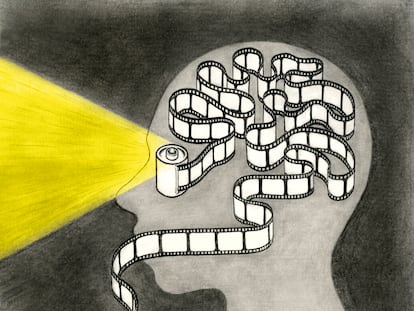Martin Parr, photographer: ‘When the absurdity of the world presents itself, I take the shot’
The great chronicler of the middle class, which he has portrayed with great humor in his images, is always on the lookout for ‘the great photo waiting to be taken’
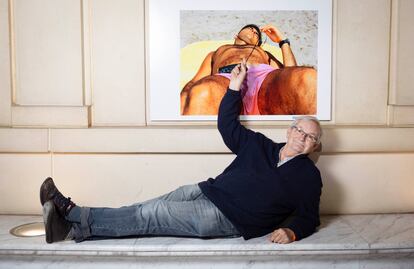

The English photographer Martin Parr, 72, is considered one of the most important documentary photographers of the past half-century. Parr — who was president of the Magnum Photos agency from 2013 to 2017 — was the guest star of Fujikina in Barcelona, an international photography festival held in various cities worldwide, including New York, Tokyo, Stockholm, Berlin, and Arles. Organized by Fujifilm, the event took place on the weekend of November 16 and 17 at the Teatre Nacional de Catalunya, and featured lectures by photographers who showcased their work, including Parr: around 400 people, mostly young, attended his talk. The event also included workshops, photo walks with professionals, and demonstrations of Fujifilm products.
Parr’s work is known for its humorous and ironic perspective on the society of leisure and consumption, primarily focusing on the middle class. His style is unmistakable, characterized by bright, saturated colors that depict a kitsch world. Parr also made headlines in Barcelona as his documentary, I Am Martin Parr, premiered at the opening of the Documentary Film Festival on Art (DART) the previous Wednesday. The film explores the life of Parr, who was introduced to photography by his grandfather as a child.
Parr studied photography in Manchester, but was soon disillusioned, so he began working on his own projects. Although he started in black and white, he switched to color in the early 1980s. “There was no turning back,” he says of that decision. His photos have been exhibited in major museums across the world. At the Fujikina (which was invited by Fujifilm to attend), EL PAÍS was the only Spanish media outlet to interview him. Parr has a reputation for not being particularly fond of interviews, but at the press conference afterward he was talkative and answered questions from the audience with interest: “The Queen [Elizabeth II] was the only person in the whole world you could photograph from behind and recognize,” he said, when he brought up an iconic photograph he took of the monarch from behind at a birthday celebration.
Question. Why have you made humor and irony the hallmark of your photography?
Answer. Because for me, the world is an absurd place. And in my work I reflect what I see, what I encounter, and every day I encounter the absurd.
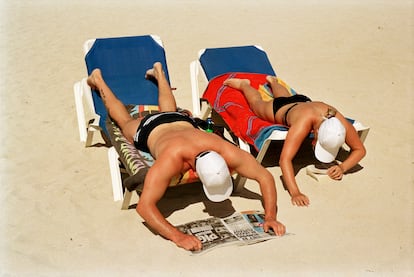
Q. What are the advantages of depicting reality like this, with this kind of humor?
A. Humor makes the work accessible. I want people to take away what they want from what they see in my photos.
Q. How do you feel knowing that your images bring joy and laughter to those who see them?
A. I think it’s good because that’s the purpose of my work, to reflect my point of view, to reflect that the world is absurd.
Q. What do you look for when you take a photograph?
A. Well, I intentionally place the camera in a specific place, I look for moments, rhythms, and when the absurdity of the world presents itself, I take the shot. [He would later say in his talk that what he seeks with his photos “are reactions, not changing mentalities or attitudes”].
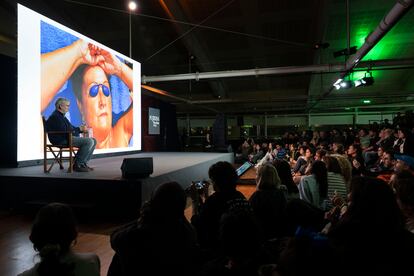
Q. You have been particularly interested in the middle class, in beaches, for example.
A. Beaches are different depending on the country you are in. You notice different behavioral habits. In India, people dress well on the beach, while in Brazil it is the opposite. I am attracted to beaches because it is where people go to relax, during their time off, during their holidays, and there I find a contradiction, a tension. Because, on the one hand, they aren’t dolled up, they don’t care about how they look, but on the other hand they show a certain restraint.
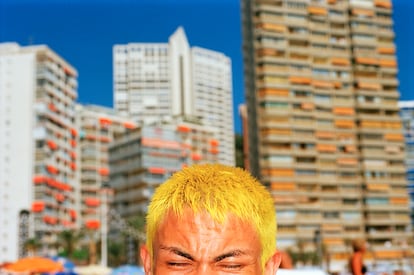
Q. Have you been able to take photos during your visit to Barcelona?
A. I already have a project dedicated to Barcelona. I won’t have time now, if I stayed here longer, of course I would go out with the camera. My work on Barcelona is dedicated to tourism. So are my projects on Benidorm, Málaga...
Q. Speaking of beaches, you have probably been told about the late Spanish photographer Carlos Pérez Siquier, who had a very similar a style to yours.
A. Yes, I know who Carlos Pérez Siquier is and, yes, I know his work and I respect it greatly.
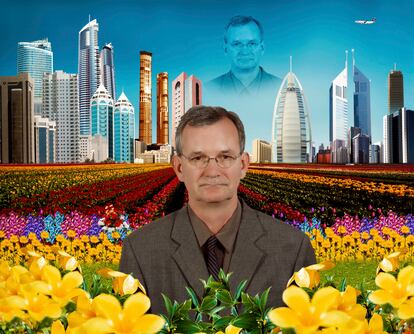
Q. What are your thoughts on the sheer number of images we encounter daily and the ones we capture on our phones? You explored this topic in your 2019 book, Death by Selfie, created in India.
A. I gave it that title because I saw on Wikipedia that a lot of people die every year while trying to take a selfie. I explain this in the book. And since India is the country with the highest number of deaths from this cause, if that was going to be the subject of my book, I was going to have to go to India. It’s crazy, really. Today, for example, about 15 people took selfies with me [to which a few more will join, including the interviewer]. And I don’t know what they will do with them, maybe they will delete them from their phones. In my case, if I take a photo that I want to take, I keep it, I download it from my iPhone, but most people don’t do that.
Q. Do you think that your work from decades ago, which was criticized by your peers, is now better understood thanks to social media?
A. I understand that, as a result of this proliferation of photographs due to technology and the fact that I have been working for many years, my photographs are taken more seriously. My goal is for my images to remain attractive and different.
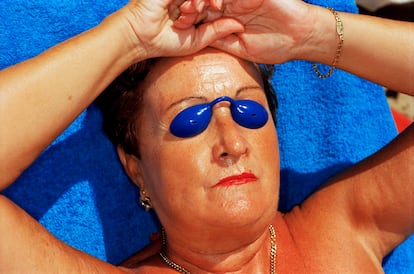
Q. You’ve published over a hundred photography books. Why have you stated at times that the photo book is underrated in the history of photography?
A. The history of photography has usually been written by academics, who do not understand the practical work of photographers. For a photographer, making a book is the ultimate expression of their work, as it is a declaration of intent.
Q. How have you combined commercial assignments, such as fashion, for example, with personal projects in order to achieve financial stability?
A. It’s been easy. I’ve done fashion assignments, which are commercial jobs, well paid. Martin Parr is asked to do fashion projects, and he has no problem doing them.
As he listens to the questions, Parr taps the table with a tissue, sometimes looking up at the crowds at the festival. Suddenly, he stops tapping and looks at his interlocutor's papers.
—Are those all questions? (laughs)
—No, no, they are my notes and phrases that you have said...
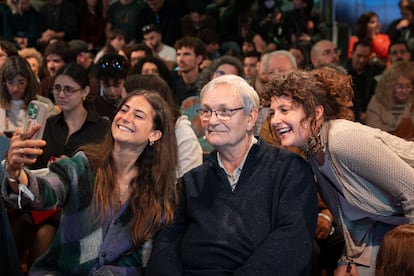
Q. You were the president of the famous Magnum Photo agency, which you joined in 1994. How does Magnum survive today with so much competition?
A. Most of the photo agencies have closed down. I think Magnum's greatest asset is its photographic archive, which includes, among others, my work on everyday life, as well as many other realities, wars, conflicts, which other Magnum photographers have documented for 75 years.
Q. In 2017, you created the Martin Parr Foundation in Bristol, which supports photographers and organizes events, workshops, exhibitions...
A. The aim of the foundation is to provide a space for British photographers who have been underestimated or undervalued to publish their work.
Q. How does Martin Parr continue to take on the challenge of photographing after so many years?
A. There is always a great photo waiting to be taken, always a shot still to be captured, and you live with that hope — the hope of capturing the next photograph.
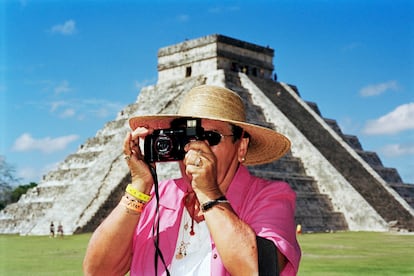
Sign up for our weekly newsletter to get more English-language news coverage from EL PAÍS USA Edition
Tu suscripción se está usando en otro dispositivo
¿Quieres añadir otro usuario a tu suscripción?
Si continúas leyendo en este dispositivo, no se podrá leer en el otro.
FlechaTu suscripción se está usando en otro dispositivo y solo puedes acceder a EL PAÍS desde un dispositivo a la vez.
Si quieres compartir tu cuenta, cambia tu suscripción a la modalidad Premium, así podrás añadir otro usuario. Cada uno accederá con su propia cuenta de email, lo que os permitirá personalizar vuestra experiencia en EL PAÍS.
¿Tienes una suscripción de empresa? Accede aquí para contratar más cuentas.
En el caso de no saber quién está usando tu cuenta, te recomendamos cambiar tu contraseña aquí.
Si decides continuar compartiendo tu cuenta, este mensaje se mostrará en tu dispositivo y en el de la otra persona que está usando tu cuenta de forma indefinida, afectando a tu experiencia de lectura. Puedes consultar aquí los términos y condiciones de la suscripción digital.
More information
Archived In
Últimas noticias
All the effects of gentrification in one corner of Mexico’s Colonia Roma
Palestinian reporter Youmna El Sayed: ‘My family told me I had to choose between being a journalist or a mother’
Russell Tovey: ‘I was advised many times not to come out, I don’t think there was many people who’d done that — and I feel really proud that I’m one of those that did’
Merz tries to replace Macron at the helm of Europe
Most viewed
- The low-cost creative revolution: How technology is making art accessible to everyone
- Christian Louboutin: ‘Young people don’t want to be like their parents. And if their parents wear sneakers, they’re going to look for something else’
- US sanctions against jailed cartel leader ‘El Marro’ highlight Mexico’s lack of control over its prisons
- Families demand repatriation of bodies of Colombians who died in Ukraine: ‘This war is a slaughterhouse for foreigners’
- Liset Menéndez de la Prida, neuroscientist: ‘It’s not normal to constantly seek pleasure; it’s important to be bored, to be calm’
